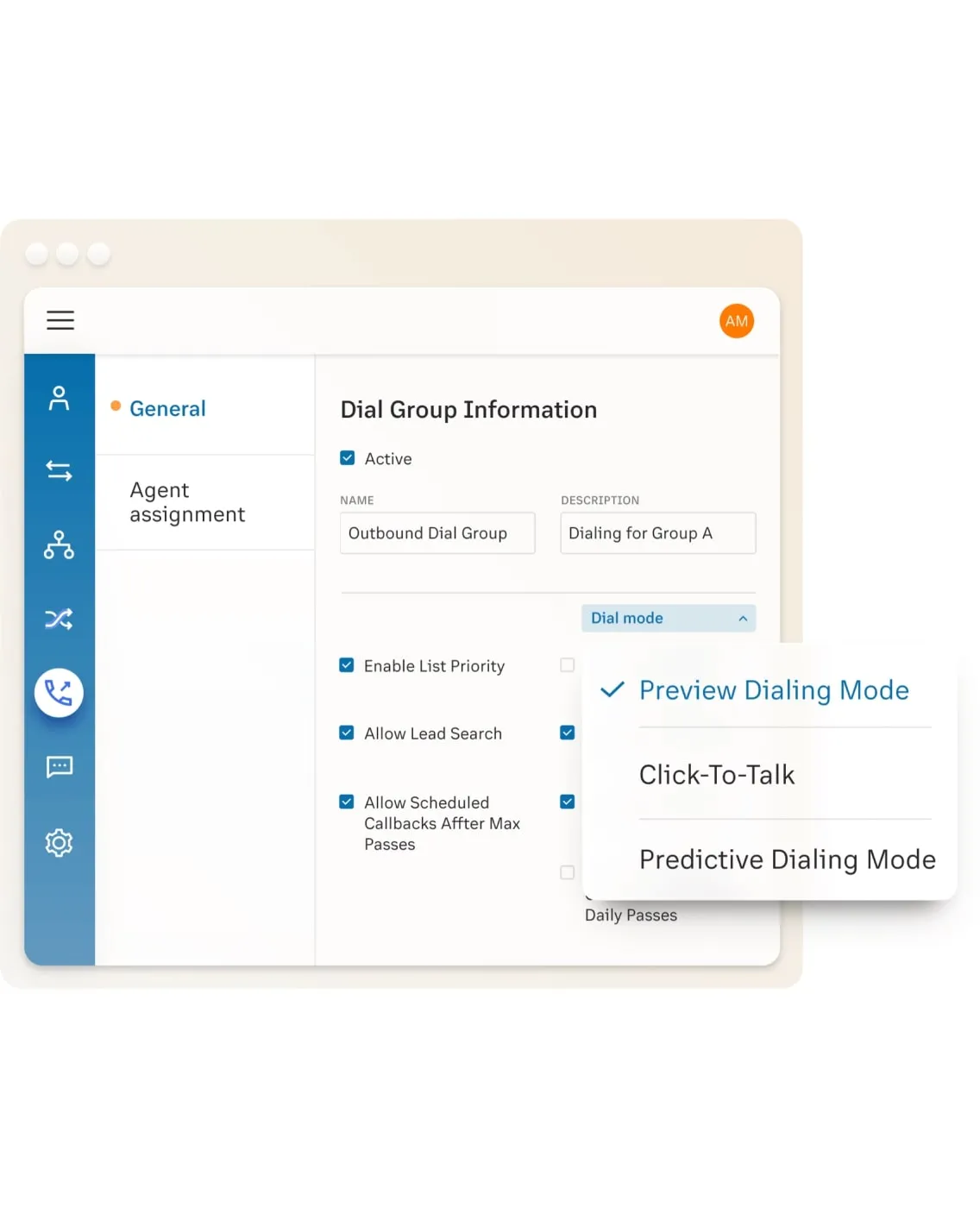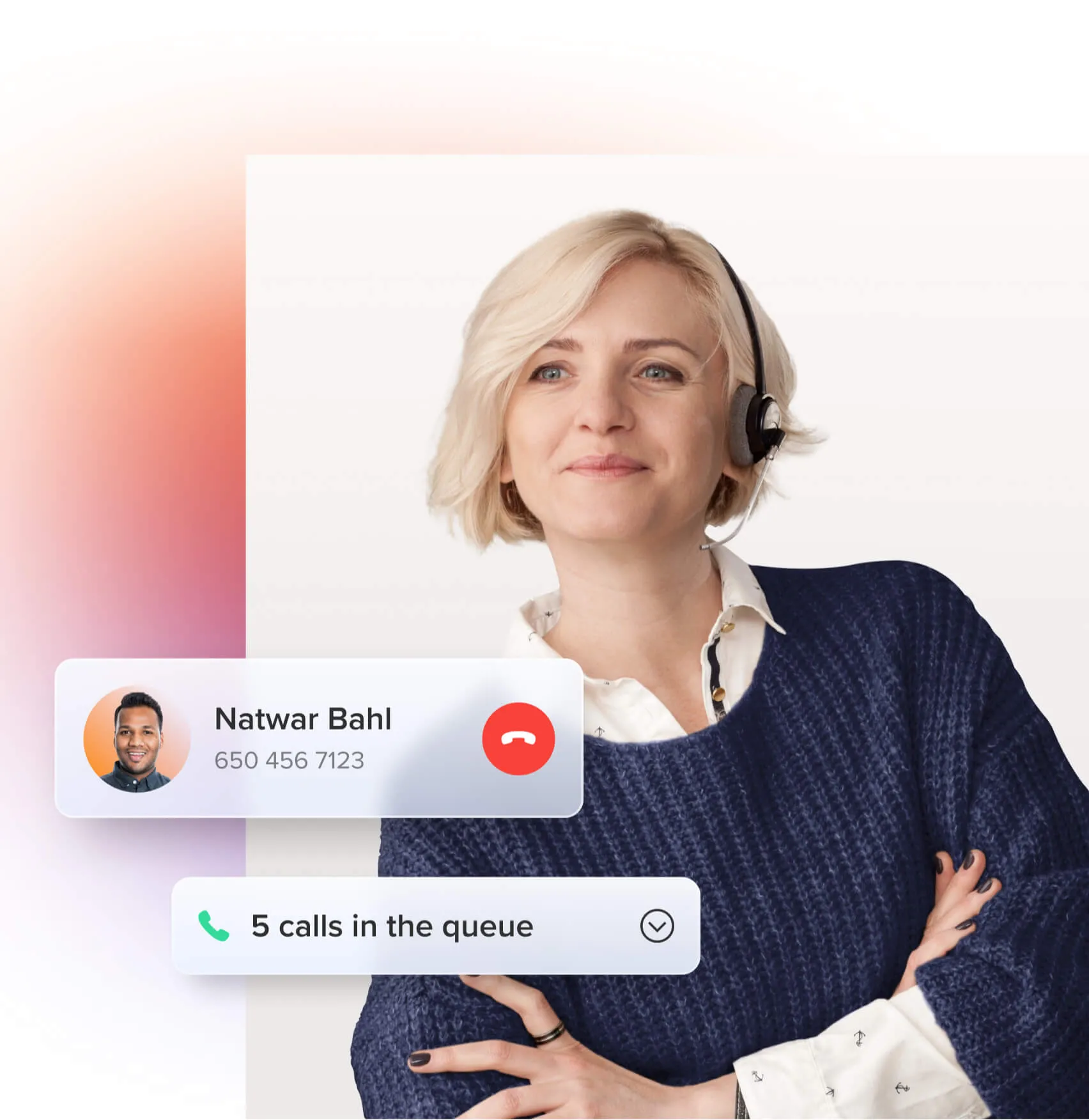
For a call center or contact center to be successful, efficiency is key. Agents are expected to handle as many calls as possible in order—and automated tools are one of the best ways to make that happen.
Predictive dialing software has become a popular solution for many companies, especially in outbound call centers. We’ll talk you through how a predictive dialer improves agent productivity and boosts the sales process to help your business hit - and even exceed - its goals.
Contents:


free agents when the
dialer starts
connected to a real
person
accomplishes the
business goal
predictive model in
real-time
(Again) and accomplishes
the business goal with
virtually zero idle time
What is a predictive dialer?
How does a predictive dialer work?
Now, let’s look at how predictive dialers work. As we mentioned earlier, they are able to predict when agents will be free to take the next call, and the dialer calls numbers on the agent’s behalf. To do this, they use mathematical algorithms.
Thanks to a “pacing algorithm”, predictive dialer software calculates the average length of a phone call and the average number of dials it takes to make a connection. It then modifies the dialing rate according to its predictions.
If a call goes unanswered, the predictive dialer automatically moves on to the next number in a pre-set list—meaning agents don’t have to search for contacts. Because multiple numbers are dialled at the same time, the seamless flow of live calls ensures minimal downtime.
Predictive dialers can also analyze unsuccessful calls and alert agents when a customer requires a call back. They use call metrics to collect and monitor data related to your operations, making it simpler to run multiple campaigns simultaneously.
If you choose an intuitive solution such as RingCentral Engage Voice, the system is easy to set up and use. All you need to do is program it with a list of contact numbers, plus scripts to optimize call durations.
Call center agents simply set their status to “available”, connect to a session, and the predictive dialer starts going through the list. The call details and script will appear on-screen once the call connects to a live person. To end the call, agents simply use the hangup button as normal.
Predictive dialers vs other auto-dialers
Predictive dialers should not be confused with other outbound dialers such as progressive dialers, preview dialers, and robo-dialers.
| Type | How it works | Use cases |
|---|---|---|
| Progressive dialer | Places one call at a time, and only dials numbers when an agent is available | Prioritizing quality interactions over quantity of calls |
| Preview dialer | Enables agents to view customer call records for better insights | Low-volume calls to high-value clients, complex sales, and follow-ups |
| Robo-dialer | Send out pre-recorded voicemail or SMS to multiple customers, or leave recorded message on answering machines | Product updates, reminders, segmented prospecting |
Why should I use a predictive dialer?
There are many reasons why companies choose a predictive dialing system, including:
- Increased productivity
- Improved accuracy
- Advanced analysis
- Versatility
- Integrations with other platforms.
The major draw for outbound call centers is improved efficiency. Predictive dialers vastly increase the number of calls made and the number of calls answered, with some reports claiming a boost in productivity by 200 to 300 percent.
Manually dialing a number can take as long as 30 seconds, and agents may inadvertently dial the wrong digits. Auto dialers are much faster, and they improve accuracy by eliminating the human-error factor. Plus, they cut the waiting time in between calls and reduce the amount of time spent on unanswered calls.
Predictive dialers also help you boost sales by connecting agents with viable leads. Even in an inbound call center, the technology can be used for proactive customer service, such as follow-up calls or information on a product feature or upgrade.
Another advantage of predictive dialers is their versatility. Often used in the banking sector for debt collection, they are now used by a wide range of businesses, including outbound sales and telemarketing, fundraising, market research, and political canvassing.
Predictive dialers are great for B2C applications because they use direct-dial numbers and require short and consistent call lengths. They are most effective in centers with relatively large teams and high call volume, where the dialer has enough data to make predictions.
You can also use a predictive dialer to improve the customer experience through data analysis, and quality management. Some dialers integrate with CRMs to give better visibility of call metrics.
A cloud predictive dialer has the additional advantages of reducing hardware and IT maintenance costs. It can also be used by remote teams, unlike on-site hardware options. Providers such as RingCentral make it easy to migrate to a virtual call center offering omnichannel solutions.

Are there any drawbacks to predictive dialing?
Predictive dialer systems require data from multiple agents in order to make predictions, so they may not be so beneficial for small businesses. They don’t leave any time for research between calls, so the sales rep doesn’t get much insight.
The efficiency of predictive dialers can have a downside, in that agents who are evaluated on the minutes per hour they spend on calls don’t have much time to build client relationships. If you need to prioritize leads for high-value sales rather than cold calling, manual outbound dialing or an alternative dialer, like a power dialer, may be more suitable.
There are also concerns surrounding the legality of predictive dialers. They’re not illegal, but those without pre-established consent for the numbers they call are banned by the FCC.
The TCPA or the Telephone Consumer Protection Act restricts the use of predictive dialers, specifically for unwanted solicitation like telemarketing, without prior consent. The law emphasizes that without consent, companies must follow prescribed rules when making contact with consumers—otherwise, they may face penalties for non-compliance.
That is why it’s important that call center managers keep and maintain a Do Not Call (DNC) database, to avoid breaking the law.
First steps for using a predictive dialer
With a wide range of auto-dialer solutions and multiple dialing modes to choose from, it’s important to do your research and figure out which would best suit your business. Exploring solutions by industry and looking at contact center trends may be helpful.
You should also keep your business goals in mind, and determine the criteria you’ll use to measure metrics such as call ratio. Most call centers seek to find a balance between minimizing abandon rate and reducing idle time for agents.
Predictive dialer systems can usually be tailored to your specific needs. For example, you could program the software to keep agents “unavailable” for a set amount of time after a call ends, so they have time to complete research or admin tasks.
All employees should receive training on how the system works and what’s expected of them. Managers should explain to agents how predictive dialing will benefit them and the company.

What’s the best predictive dialer software?
The best solution for you will depend on the nature of your organization, but it definitely makes sense to choose something that gives you overall value for money.
We’ve already mentioned the benefits of a cloud-hosted dialer—and if you combine that with a call center software package, you’ll have all the functionality you need. RingCentral goes one better by teaming a contact center solution with unified communications for the most comprehensive range of services.
Our predictive dialer system has advanced features like call scheduling, which uses metrics to set the exact time when a customer will be available and gives preference to the scheduled client.
It also models the probability of calls connected to a real person, and will analyze and rebuild the predictive model in real time after each call. You’ll get live-reporting dashboards, speech analytics, automated call recordings, and coaching capabilities.
RingCentral has you covered for inbound calls, too—with Automatic Call Distribution (ACD), skills-based routing, and Interactive Voice Response (IVR). For both inbound and outbound call centers, agents have quick access to all the customer information they need.
Other key features include:
- Local caller ID
- Virtual agent function
- 99.99% uptime
- Time-zone conscious technology
- Linked to national Do Not Call registry
- TCPA-compliant